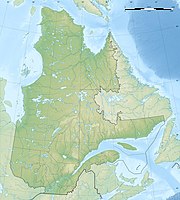Réserve écologique des Îles-Avelle-Wight-et-Hiam
|
Réserve écologique des Îles-Avelle-Wight-et-Hiam
|
||
| location | Vaudreuil-Soulanges , Québec, Canada | |
| surface | 0.9 km² | |
| WDPA ID | 66621 | |
| Geographical location | 45 ° 27 ′ N , 74 ° 0 ′ W | |
|
|
||
| Setup date | 1994 | |
| administration | MDDEP | |
The Réserve écologique des Îles-Avelle-Wight-et-Hiam is an ecological reserve in the south of the Canadian province of Québec , in the regional county municipality of Vaudreuil-Soulanges .
The reserve was established in 1994 on an area of 90 hectares and comprises a system of islands and islets in the Baie de Vaudreuil (Vaudreuil Bay) in the Lac des Deux Montagnes west of Montréal . The three most important islands are Avelle , Wight and Hiam . The lake is fed by the Ottawa . The reserve is in the territory of the municipality of Vaudreuil-Dorion .
In Québec, rare or threatened plant communities are protected, but also trees such as the American white oak ( Quercus alba ) or the American red oak ( Quercus rubra ). It represents the ecoregion on the lower St. Lawrence River .
The subsoil consists mainly of sandstone and quartz grit , which is called Grès de Potsdam here . Above are sediments deposited by the river. In the higher elevations there is tillite , which is overlaid by alluvial land in the lower elevations. While the higher areas drain well, this is not possible in the lower areas. Only Avelle can be addressed as a real mainland; dominate there sugar maple - hickory woods are and endangered species American Pimpernuss ( Staphylea trifolia ) can be found there. In the places where there is frequent flooding, moisture-loving trees grow accordingly. Between the islands there are shoals that are inhabited by numerous aquatic plants and animals.
In the areas near the shore there are plant communities in which the silver maple ( Acer saccharinum ) plays a central role, as well as the scale bark hickory ( Carya ovata ), a tree species from the genus Hickory (Carya), and Carya cordiformis from the family of Walnuts . In addition, there is the two-tone oak (Quercus bicolor) classified as endangered . The same applies to Onoclea sensibilis from the family of the fern family , the western button bush ( Cephalanthus occidentalis ), but also to the red ash ( Fraxinus pennsylvanica ). The red oak ( Quercus rubra ) completely dominates the island of Hiam, while American white oak ( Quercus alba ) and red oak dominate the southern part of Wight.
In addition, there are 14 groups of aquatic plant groups. In the shallower waters, Sparganium eurycarpum from the genus of the hedgehog cob and branch hedgehog ( Sparganium erectum ), broad-leaved arrowhead ( Sagittaria latifolia ) and heart-leaved pike ( Pontederia cordata ) dominate. In the slightly deeper areas there are tuberous water lilies ( Nymphaea tuberosa ), Vallisneria americana from the frog-bite family and water rice ( Zizania palustris ).
An endangered species in the protected area of the Western hackberry (Celtis occidentalis), the white oak, Quercus bicolor, staphylea belong Claytonia virginica from the kind of claytonia , Scipe de Torrey, the branchy bur reed and Saururus cernuus Linnaeus .
The fauna is still little explored. It is known that the American perch ( Perca flavescens , French: Perchaude ), the largemouth bass ( Micropterus salmoides , French: Achigan à grande bouche ), the pike ( Esox lucius , French: Grand brochet ) and the (brown) catfish ( Ameiurus nebulosus , French: Barbotte brune ) live here. Among mammals, the muskrat ( Ondatra zibethicus ) should be mentioned, which the vegetation and the landscape are very useful. Amphibians and reptiles are rarely represented, and turtles may be found in some of the bays.
Web links
- Réserve écologique des Îles-Avelle-Wight-et-Hiam , government website
Remarks
- ↑ Lézardelle penchée. Saururus cernuus Linné on the website of the responsible ministry.




